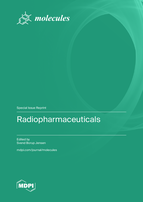Radiopharmaceuticals
A special issue of Molecules (ISSN 1420-3049). This special issue belongs to the section "Medicinal Chemistry".
Deadline for manuscript submissions: closed (10 October 2023) | Viewed by 53998
Special Issue Editor
Interests: radiochemistry; radiopharmacy; GMP-production; drug degradation; receptor kinetics; analytical methods; chelation; medicinal chemistry
Special Issues, Collections and Topics in MDPI journals
Special Issue Information
Dear Colleagues,
In line with the three previous Special Issues that I have guest-edited for Molecules, this issue is about radiopharmaceuticals and related topics: simply named "Radiopharmaceuticals". I hope authors contribute articles and reviews dealing with all aspects of radiopharmaceuticals. The subject may vary from radioactive isotope production, the synthesis of precures, radioactive labeling reactions, and the purification of radiopharmaceuticals to quality control and regulatory efforts, which are required prior to using radiopharmaceuticals in humans. The above could be used, for example, in combination with in vitro studies or in vivo animal studies, in the degradation and/or uptake profiles of the radiopharmaceutical along with modeling of the radiopharmaceutical distribution, in metabolism, in uptake, and in excretion.
The purpose of this Special Issue is to host research and review papers on radiopharmaceuticals.
Dr. Svend Borup Jensen
Guest Editor
Manuscript Submission Information
Manuscripts should be submitted online at www.mdpi.com by registering and logging in to this website. Once you are registered, click here to go to the submission form. Manuscripts can be submitted until the deadline. All submissions that pass pre-check are peer-reviewed. Accepted papers will be published continuously in the journal (as soon as accepted) and will be listed together on the special issue website. Research articles, review articles as well as short communications are invited. For planned papers, a title and short abstract (about 100 words) can be sent to the Editorial Office for announcement on this website.
Submitted manuscripts should not have been published previously, nor be under consideration for publication elsewhere (except conference proceedings papers). All manuscripts are thoroughly refereed through a single-blind peer-review process. A guide for authors and other relevant information for submission of manuscripts is available on the Instructions for Authors page. Molecules is an international peer-reviewed open access semimonthly journal published by MDPI.
Please visit the Instructions for Authors page before submitting a manuscript. The Article Processing Charge (APC) for publication in this open access journal is 2700 CHF (Swiss Francs). Submitted papers should be well formatted and use good English. Authors may use MDPI's English editing service prior to publication or during author revisions.
Keywords
- radiochemisty
- radiopharmacy
- incorporation of radioactive isotopes into biological interesting compounds
- PET and SPECT molecules
- radioactive labeling
- purification techniques
- quality control of radiopharmaceuticals
- radioactive labeled compounds metabolic pathway ADME (absorption, distribution, metabolism, and excretion)
Related Special Issues
- Radiochemistry in Molecules (4 articles)
- Preparation of Radiopharmaceuticals and Their Use in Drug Development in Molecules (10 articles)
- Past, Present, and Future of Radiochemical Synthesis in Molecules (11 articles)







